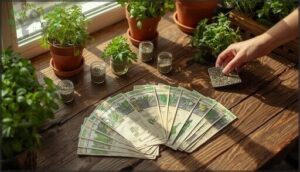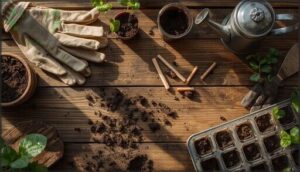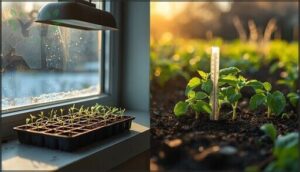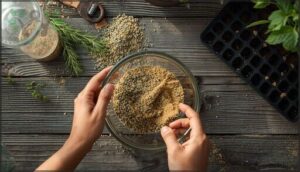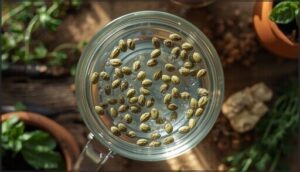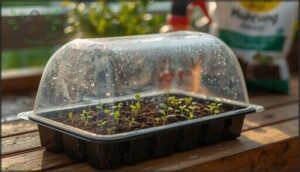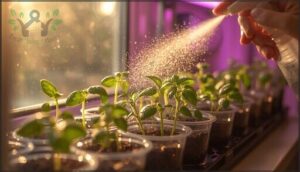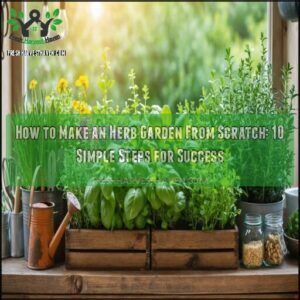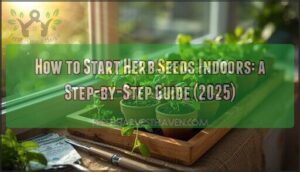This site is supported by our readers. We may earn a commission, at no cost to you, if you purchase through links.
You can buy a basil plant at the nursery for six dollars or grow twenty from a seed packet that costs two. That simple math explains why experienced gardeners rarely buy starter plants anymore.
Beyond the obvious savings, growing herbs from seeds creates opportunities to varieties you won’t find in any garden center. You’ll discover rare basils with cinnamon notes, parsleys that tolerate heat, and dozens of specialty herbs that simply don’t ship well as young plants.
Starting from seed also means you control everything from day one—no mystery fertilizers, no hidden pests, and no transplant shock from someone else’s growing choices. This guide walks you through each step of the process, from selecting quality seeds to nurturing your first seedlings into productive plants that fill your kitchen with fresh flavor.
Table Of Contents
- Key Takeaways
- Why Grow Herbs From Seed?
- Choosing The Best Herbs and Seeds
- Preparing to Start Herb Seeds
- Step-by-Step Guide to Sowing Herb Seeds
- Caring for Herb Seedlings and Young Plants
- Top 7 Products for Growing Herbs From Seed
- Frequently Asked Questions (FAQs)
- What is the best way to start herbs from seed?
- What’s the easiest herb to grow from seed?
- Is it worth growing herbs from seeds?
- How long does it take to grow herbs from seeds?
- What is the easiest herb to grow from seeds?
- What herbs should not grow from seed?
- Should you soak your herb seeds before planting?
- How long can I store unused herb seeds?
- When is the best time to harvest herb flowers?
- Can different herb varieties cross-pollinate in my garden?
- Conclusion
Key Takeaways
- Growing herbs from seed costs half as much as buying starter plants while giving you access to hundreds of rare varieties that never appear in nurseries, plus complete control over soil quality and growing conditions from day one.
- Most herbs germinate within 7 to 21 days when you maintain soil temperatures between 65°F and 75°F, use sterile seed-starting mix with good drainage, and provide 14 to 16 hours of light daily once seedlings emerge.
- Success comes from mastering three critical techniques: even sowing by mixing tiny seeds with sand, maintaining 70-90% humidity without overwatering to prevent damping-off disease, and hardening off seedlings gradually over 7 to 10 days before transplanting outdoors.
- Beginners should start with forgiving herbs like basil (which germinates in 5-10 days with 90%+ success rates), dill, and parsley, while avoiding difficult varieties like French tarragon and rosemary that require division or have poor germination rates.
Why Grow Herbs From Seed?
Starting herbs from seed might seem like extra work, but it’s one of the smartest moves you can make as a gardener.
The benefits go far beyond just saving a few dollars at the nursery. Here’s why growing herbs from seed is worth your time and effort.
Cost Savings and Variety
One seed packet costs less than a single bunch of store-bought herbs yet produces dozens of plants. You’ll spend around $7.50 to $10.50 annually growing culinary herbs from seed versus $18 to $26 for starter plants.
Growing herbs from seed costs half as much as buying starter plants and produces dozens more
Seed starting unlocks hundreds of herb varieties unavailable at nurseries, from rare basils to heirloom thyme. This affordability and variety access make herb gardening both economical and exciting for exploring new flavors.
Starting with herbs like basil, sage, and cilantro means you can grow herbs easily.
Organic and Sustainable Gardening
Growing herbs from seed encourages organic gardening principles by reducing chemical dependence and promoting natural pest control. Seed starting also aids water conservation since you can choose native varieties requiring less irrigation. These sustainable practices improve carbon sequestration in your garden while giving you complete control over soil preparation and planting techniques from day one.
You’ll build healthier soil through composting while fostering biodiversity with pollinator-friendly plants. Using native plants in your herb garden can also support local ecosystems.
Greater Control Over Growing Conditions
Starting herbs from seed gives you complete oversight of soil composition, temperature regulation, and moisture control from the beginning. You can customize planting techniques to match each herb’s needs while using growing lamps for perfect light management during seed germination.
This precision in indoor gardening and seed starting and care creates stronger plants with better flavor than store-bought seedlings ever could.
Benefits for Beginner Gardeners
Beyond control, growing herbs from seed offers real advantages for beginners. You’ll find ease of starting with herbs like basil and parsley, which germinate in just 7 to 14 days.
Cost savings add up fast when seed packets replace expensive seedlings.
The skill building improves your understanding of plant life cycles, while the mental wellness benefits reduce stress by up to 30%.
Plus, you’ll access vast herb variety unavailable in stores.
Choosing The Best Herbs and Seeds
Your choice of herbs and seeds sets the foundation for everything that follows. Some herbs grow faster and forgive beginner mistakes, while others need specific conditions to thrive.
Let’s look at how to pick the right herbs for your skill level and climate, plus what to watch for when buying seeds.
Popular Herbs for Beginners (Basil, Dill, Parsley, Etc.)
You’ll find basil stands out as your first pick when growing herbs from seed. Its germination takes just 7 to 21 days in warm conditions. Dill follows close behind with easy outdoor sowing and forgiving spacing needs.
Parsley requires patience—soaking seeds speeds things up after their typical 2 to 4 week wait. Sage is easy to grow while cilantro thrives in cooler seasons.
Selecting High-Quality Seeds
Quality matters when you’re buying herb seeds. Look for certified options with at least 98% seed purity and germination rates above 80%. In recent trials, basil seeds hit 81% germination while dill reached 79%.
Organic seeds follow strict regulations and cause fewer growing problems than untreated conventional varieties. Check that your seed packets come from reputable suppliers with proven track records.
Understanding Seed Packets and Viability
Seed packets hold critical information about viability and germination rates. Most herb seeds stay viable for one to two years when stored properly. Look for packets that show germination rates between 80% and 92%.
The sell-by date indicates freshness, usually valid for nine months after testing.
Storage conditions matter—keep seeds cool and dry where temperature plus humidity stays under 100.
Considering Climate and Growing Conditions
Your local climate shapes which herbs thrive and which struggle. Temperature swings, frost dates, and sunlight hours all influence seed germination timing and plant success.
Consider these growing conditions before choosing your seeds:
- Soil temperature requirements—most herbs need 65°F to 85°F for germination
- Microclimate factors like slope exposure and wind patterns
- Drought resistance needs if water is scarce
- Soil drainage quality to prevent root rot
Preparing to Start Herb Seeds
Getting your herb seeds off to a strong start doesn’t require fancy equipment, but a little preparation goes a long way. You’ll need to decide where your seedlings will spend their early days and gather a few basic supplies to give them the best shot at thriving.
Let’s walk through the essentials you’ll want to have ready before you plant your first seed.
Choosing The Right Growing Location (Indoors Vs Outdoors)
Your first choice shapes everything that follows: indoor or outdoor growing. Indoor gardening gives you temperature control and pest management advantages, but herbs generally need 12 to 16 hours of artificial light daily.
Outdoor gardening offers natural sunlight and air circulation, yielding larger harvests, though you’ll face weather challenges.
Consider your space, climate, and commitment to watering before deciding.
Selecting and Preparing Seed Starting Mix
Think of your growing medium as the foundation of your herb garden. Choose a well-draining soil preparation blend containing peat moss or coir for moisture balance, plus perlite for aeration.
This seedstarting mix composition prevents disease by staying sterile while offering low nutrient content that won’t burn tender roots. Check pH levels between 5.5 and 6.5.
Moisten your organic matter thoroughly before filling containers.
Gathering Essential Seed Starting Supplies
Once you’ve prepared your seed starting mix, you’ll need the right seed starting supplies. Budget options include recycled containers, but investing in quality seed trays and small pots pays off season after season.
Your basic checklist includes:
- Seed tray types with drainage holes plus a plastic dome to maintain moisture balance
- LED grow lights (lighting costs vary but guarantee strong seedlings)
- Seed labels to track your herb varieties
Soil Temperature and Moisture Requirements
With your supplies ready, focus on two critical factors that determine successful germination: ideal temperatures and moisture levels. Most herb seeds thrive when the soil temperature reaches 70°F. However, germination rates decline rapidly below 60°F or above 85°F.
To ensure seedling vigor, maintain soil moisture without letting it become soggy. Adjust your watering practices based on soil type: sandy soils dry out quickly, while clay soils retain water longer.
| Temperature Range | Germination Success |
|---|---|
| 65–75°F | Best for most herbs |
| Below 60°F | Slows emergence noticeably |
| Above 85°F | Inhibits seed development |
Step-by-Step Guide to Sowing Herb Seeds
Now that you’ve gathered your supplies and prepared your workspace, it’s time to actually get those seeds in the soil. The sowing process is simpler than you might think, but a few smart techniques will set you up for better germination and healthier seedlings.
Let’s walk through the key steps that make all the difference.
When to Start Herb Seeds Indoors or Outdoors
Before you start herb seeds indoors or outdoors, understand how frost dates and regional climate influence your success. Indoor start timing should align with germination temperatures and transplant goals, while outdoor sowing success depends on soil warmth.
When choosing the right time for starting herbs from seed, consider:
- Indoor sowing: Begin 6–8 weeks before your last frost date
- Hardy herbs outdoors: Direct sow 2–4 weeks before frost passes
- Tender herbs outdoors: Wait until nighttime temperatures stay above 50°F
Techniques for Even Sowing (Mixing Tiny Seeds With Sand)
Once you’ve picked your timing, your next step is even sowing. Mixing tiny herb seeds with horticultural sand creates uniform distribution and prevents clumping. A 1:4 seed-to-sand ratio works well for most fine seeds like dill and oregano. This low-cost technique improves seed spacing and reduces thinning later.
| Seed Type | Sand Ratio | Planting Depth |
|---|---|---|
| Dill | 1:6 | Surface press |
| Oregano | 1:4 | ⅛ inch |
| Parsley | 1:5 | ¼ inch |
| Thyme | 1:8 | Surface press |
| Cilantro | 1:4 | ½ inch |
Mix seeds with clean play sand in a shaker for controlled sprinkling across your seed-starting trays. The contrasting sand color helps you spot gaps and avoid overcrowding. This method offers germination advantages by improving drainage and airflow around each seed. You’ll see cost efficiency through better seed utilization and thinning reduction as seedlings emerge with proper spacing.
Soaking Seeds to Improve Germination
Before sowing, you can boost germination rates by soaking herb seeds in clean water at room temperature. Eight to twenty-four hours is the best duration for most herbs. This practical application softens seed coats and jumpstarts the seed germination process through water absorption.
Soaking benefits include faster sprouting and more uniform germination by activating physiological mechanisms that break seed dormancy naturally.
Maintaining Humidity and Preventing Damping Off
Once your seeds are in the soil, maintaining humidity between 70% and 90% aids seed germination while preventing damping-off disease. Cover seed trays with plastic to retain moisture, but provide daily ventilation to prevent mold.
Use sterile, well-draining soil and bottom watering techniques to keep moisture consistent without soaking the surface. These cultural practices reduce seedling losses by up to 60% through proper moisture control.
Caring for Herb Seedlings and Young Plants
Once your herb seeds sprout, your work isn’t finished. Young seedlings need the right light, moisture, and care to grow into strong plants.
Here’s how to nurture your seedlings through their critical early weeks and get them ready for the garden.
Light and Airflow Requirements (Using Grow Lamps)
Your herb seedlings need about 14 to 16 hours of light daily under growing lamps to thrive. Position full-spectrum LEDs 3 to 4 inches above the plants for strong growth.
Good air circulation prevents mold, so use a small fan and maintain humidity between 45% and 55%. Reflective surfaces like white walls boost light intensity.
These indoor gardening techniques improve germination rates and energy efficiency.
Monitoring Moisture and Preventing Overwatering
Watering is like steering a ship—too much and you sink. Check the top inch of soil daily, and only water when it feels dry. A moisture meter gives you precision if you’re unsure.
- Use containers with drainage holes at least ¼ inch wide
- Water at the base to avoid wetting foliage and inviting mold
- Remove humidity domes once seedlings emerge to prevent root rot
- Establish a watering schedule based on temperature and humidity levels
Well-draining soil and proper moisture control keep roots healthy.
Thinning, Pruning, and Staking Seedlings
Overcrowding stunts growth and invites trouble. Thin seedlings when they reach 2-3 inches tall with two true leaves, keeping only the strongest 2-5 plants per container. Snip extras at soil level to avoid disturbing roots.
Pruning leggy stems before transplanting creates bushier growth, while staking tall varieties improves airflow and prevents bending.
These thinning and transplanting seedlings techniques boost disease management and improve your harvest.
Fertilizing and Amending Soil for Healthy Growth
Once your seedlings sprout true leaves, they’re ready for nutrients. Feed them weekly with diluted water-soluble fertilizer to fuel steady growth.
- Fertilizer Types: Balanced NPK formulas (like 5-5-5) support all growth stages
- Organic Amendments: Mix compost or worm castings into soil for slow-release feeding
- Soil pH: Keep it between 6.5-7.5 for best nutrient absorption
- Root Development: Add mycorrhizal inoculants to strengthen root systems and nutrient uptake
Hardening Off and Transplanting Outdoors
After feeding your plants, you’ll need to prepare them for life outside. Hardening off takes 7 to 10 days and involves gradual acclimation to environmental stressors like wind and direct sun. Start seedlings in shade for a few hours daily, then increase exposure.
Transplanting herb seedlings on calm mornings reduces shock and improves survival rates. Water gently after transplanting, and your post-transplant care ensures strong establishment.
Top 7 Products for Growing Herbs From Seed
The right tools can make the difference between struggling seedlings and thriving herbs. You don’t need a garage full of equipment, but a few quality products will save you time and headaches.
Here are seven tried-and-true items that help you grow healthier herbs from the very start.
1. 4 Tier Mini Portable Greenhouse
When starting herb seeds indoors, a 4 tier mini portable greenhouse gives you the space you need without taking over your home. Assembly ease makes setup simple—no tools required—and the clear PVC cover material creates the warm, humid environment perfect for germinating seeds. Each seed tray sits on sturdy shelving with 14 inches of clearance.
While the unit offers excellent space utilization for seed starting, you’ll want to secure it against a wall due to stability concerns in windy conditions.
Market growth reflects rising demand for compact seed starting solutions.
2. Mars Hydro TS1000 LED Grow Light
Once your seedlings emerge, they need the right light to thrive. The Mars Hydro TS1000 LED grow light delivers 150 watts of full spectral output that aids seed germination through harvest. Its dimmable settings let you adjust intensity as your herbs mature, while the heat dissipation system keeps temperatures safe for delicate seedlings.
The daisy chaining feature means you can expand your indoor seed starting setup without rewiring. At 2.3 μmol/J efficiency, it replaces traditional grow lights while consuming 40% less power.
3. Premier Horticulture Pro Mix Growing Medium
After you’ve got your lighting sorted, the next critical piece is choosing the right seed starting mix. Leading Horticulture Pro Mix combines Canadian sphagnum peat moss with perlite for excellent water retention and drainage.
Its mycorrhizae benefits extend your seedlings’ root systems, while the biofungicide provides disease suppression against damping off. This OMRI-listed growing medium stays lightweight and fluffy, perfect for organic gardening practices.
The mix maintains consistent moisture without waterlogging, giving you the ideal foundation for starting herbs from seed successfully.
4. Bootstrap Farmer Seed Starter Tray Pack
Once you’ve paired quality seed starting mix with proper lighting, you need trays built to last. Bootstrap Farmer’s heavy-duty seed starter trays resist cracking and bending across multiple growing seasons, making them genuinely cost-effective despite the higher initial price.
The 72-cell design with mesh-bottom options improves the seed germination process through better drainage control. You’ll appreciate the stackable storage and dishwasher-safe cleanup.
These BPA-free trays support sustainable gardening practices while giving your herb seedlings the stable foundation they need for best seedling health and vigorous root development.
5. FoxFarm Grow Big Bloom Fertilizer
Your herb seedlings need consistent nourishment once they’ve established roots in their seed starting mix. FoxFarm Grow Big Bloom Fertilizer delivers with its 6-4-4 NPK ratio and OMRI-listed organic certification.
The micro-brewed formula combines earthworm castings and Norwegian kelp to improve nutrient uptake during critical early growth stages. You’ll see yield increases through improved root development and bushier plants.
Apply during regular watering schedules—the concentrated liquid works in both soil and hydroponic systems, making it adaptable for various gardening techniques and organic gardening methods.
6. Espoma Organic Garden Tone Fertilizer
Once your herbs reach maturity, you’ll want a balanced organic fertilizer that promotes long-term growth without chemical additives. Espoma Garden-tone delivers a 3-4-4 NPK ratio enhanced with Bio-tone microbes that strengthen roots and disease resistance—essential for sustainable gardening practices.
This OMRI-listed soil amendment works beautifully for organic seeds becoming productive plants. Apply monthly throughout the season using simple application guidelines: one-third cup per plant for established herbs. The slow-release granules prevent burning while improving soil preparation and structure naturally.
7. Earth Science Natural Blood Meal Plant Food
When your leafy herbs like basil and parsley need a nitrogen boost, Earth Science Natural Blood Meal delivers 12% nitrogen to fuel rapid growth and lush foliage.
This organic gardening powerhouse works as both fertilizer and soil amendment—mix 2-3 pounds per 100 square feet during soil preparation or side-dress established plants with 1-2 teaspoons monthly.
It’s also excellent for compost activation, balancing carbon-rich materials to speed decomposition. The adaptable application and nitrogen richness make amending the soil simple for bigger harvests.
Frequently Asked Questions (FAQs)
What is the best way to start herbs from seed?
You want consistent warmth between 65°F and 75°F for seed germination.
Choose quality seed starting supplies like well-draining mix with perlite. Pre-moisten soil, sow seeds at proper depth, and maintain humidity until sprouting begins.
What’s the easiest herb to grow from seed?
Basil stands out as the top choice for beginners. Its seeds show impressive germination rates of seventy to one hundred percent and sprout within three to fourteen days under proper conditions.
Is it worth growing herbs from seeds?
Growing your own herbs is like planting dollar bills in soil. You’ll save over $20 per season compared to store-bought bundles, while gaining organic advantages and control factors.
Despite occasional challenges, you’ll enjoy beginner-friendly germination success.
How long does it take to grow herbs from seeds?
Most herbs sprout within 7 to 21 days, depending on the variety and temperature. Basil germinates in 5 to 10 days, while parsley takes 14 to 21 days. You can harvest annual herbs in 45 to 60 days.
What is the easiest herb to grow from seeds?
If patience isn’t your strong suit, basil is your ideal companion. Starting herbs from seed becomes simple with this beginner-friendly herb, boasting fast germination rates above 90% and thriving with minimal fuss indoors or outdoors.
What herbs should not grow from seed?
French tarragon stays sterile and won’t produce viable herb seeds. Dill transplanting often fails, so direct-sow these herb varieties for reliable seedlings.
Rosemary germination rates disappoint most gardeners.
Hybrid mints need division instead of seed starting.
Should you soak your herb seeds before planting?
Soaking benefits larger seeds like beans by softening coats and speeding germination. Most herb seeds are small and don’t need soaking.
Start them directly in moist seed starting mix for best results.
How long can I store unused herb seeds?
Ever wondered if seeds last forever? Seed storage duration depends on ideal conditions and herb variability.
Basil seeds can last 5–7 years, while parsley drops off after one. Maintain viability by keeping seeds cool, dry, and labeled.
When is the best time to harvest herb flowers?
Harvest herb flowers early in the morning after the dew dries, just before they fully open.
Peak oil concentration occurs at the bud stage, maximizing flavor and essential oils before flowering diminishes leaf quality.
Can different herb varieties cross-pollinate in my garden?
Yes, varieties within the same herb species can cross-pollinate through pollinator influence when flowering overlaps.
Spatial isolation between plantings helps preserve genetic diversity and ensures reliable seed saving, preventing unexpected hybrid vigor in future harvests.
Conclusion
Yes, growing herbs from seeds demands patience that buying transplants doesn’t require. But that waiting period teaches you to read your plants, adjust conditions, and troubleshoot problems before they escalate. Those skills matter far beyond your herb garden.
Once you’ve mastered the fundamentals of growing herbs from seeds, you’ll approach every gardening challenge with confidence rooted in understanding rather than guesswork. Your kitchen will never run short of fresh flavor again.
- http://tomclothier.hort.net/page13.html
- https://wcia.wisc.edu/Hemp_proto.pdf
- https://portal.ct.gov/-/media/caes/publications/tb39.pdf?rev=6827d5386d6e470cbc49bb5764e93a29&hash=1495E971A25F81067D2AFBB978812BAB
- https://fedcoseeds.com/resources/essays/cr-lawn/organic-rule.htm
- https://www.datainsightsmarket.com/reports/herb-seeds-299211


